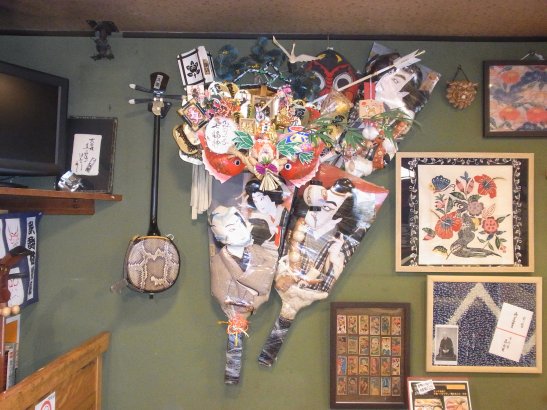
「黒石」と「白石」が交互に「碁盤」の上に音を立てて置かれます。
“Kuro-ishi 黒石 Black stones” and “Shiro-ishi 白石 White stones” are
placed on “Go-ban 碁盤 Board” alternately with click.
The
rules of “Igo” are simple.
The game
is played by two players, and the object is to gain more territory than your
opponent.
“Go-ban”
consists of a grid of 19 vertical and 19 horizontal lines.
The
players place their “Go-ishi 碁石Stones” on the
intersections of these lines in turn.
Once you put down your “Go-ishi”, you cannot move it.
The size
of your territory is calculated by the number of unoccupied “Me
So the
aim is to have more of “Me” than your opponent.
“Igo” is
said to have originated in China, about 4,000 years ago.
“Igo” also
appears in the classic literature “Makuranosōshi 枕草子” and “Genji Monogatari 源氏物語 The Tale of
Genji”.
It is
said that these authors “Seisōnagon 清少納言” and “Murasaki
Shikibu 紫式部” also played “Igo”.
On a
grid of 19 lines in each direction, the total number of intersections is 361.
Because
this is close to the number of days in a year, it was thought that “Igo” had a
close link with astronomy and astrology.
“Igo” was popular with “Bushō 武将Samurai warriors” in “Hōken-jidai 封建時代 Feudal times”.
Therefore,
it was considered a valuable hobby for “Bushō” who expand their territories by
war.
17世紀(江戸時代)にはプロの棋士も現れました。
They
competed with each other at the annual competition held in “Edo-jo 江戸城 Castle” once a year.
In
addition, “Gokaisho碁会所Go parior” where people can play Go has
made and “Igo” had become a popular entertainment for the people.
As a
result, the level of Go “Igo” in Japan has greatly improved.
Currently,
“Igo” is spreading in about 80 countries and regions.
The
influence of the comic “Hikaru no Go” has increased the number of Go lovers
overseas.
“Kuro-ishi”
is a clay-like stone called “Nachiguro 那智黒 Stone”, and “Shiro-ishi”
is made of “Hamaguri 蛤 Clam” shells.
「折り紙」は、紙を折って動植物や生活道具などの形を作る日本の伝統的な遊びです。
“Origami”
is a traditional Japanese play that folds paper to make shapes such as animals
and plants and life tools.
Many Japanese
do “Origami” as a child.
Just a
square of paper to fold, you can do “Origami”.
All
kinds of things can be fashioned with “Origami”.
Since
the old days in Japan, paper was not just something to write or paint on; it
was a sacred object invested with spiritual meaning.
It was
born in “Kamakura-jidai 鎌倉時代 Period” and was
established as one of the rituals of “Bushi 武士 Samurai” in “Muromachi-jidai 室町時代 Period”.
About
600 years ago, strict rules of etiquette were established, governing the way
paper was folded and wrapped.
The
techniques used in gift wrapping eventually gave rise to the sophisticated
craft that is called “Origami”.
Modern Japanese “Origami” was developed for play during “Edo-jidai 江戸時代 Period”.
「ニシキゴイ」は色鮮やかな美しい姿から「泳ぐ宝石」とも呼ばれています。
Since
then, breeding has continued for about 200 years.

羽根突きというゲームは、羽子板と呼ばれる精巧に装飾された櫂のような道具を使います。15世紀から宮廷内で楽しまれたことが知られています。
The game of hanetsuki (battledore), played with elaborate paddles called
hagoita, has been in existence since the fifteensh century, when it was
played at the Imperial Court.
多くの点でバドミントンと似ていますが、正月休みに女性だけが楽しむゲームとして伝えられてきました。
In many ways similar to badminton, this game is traditionally reserved
for females and played only during the New Year's holidays.
毎年12月17日から同19日まで浅草の浅草寺の境内で開催される羽子板市は、江戸時代に始まりました。
Nowadays one has to look long and hard to fine a New Year's tourney even
though the decorative paddles, the hagoita, are the focus of a huge, lively
festival every December at Tokyo's Asakusa Kannon temple grounds.
考えられる形と大きさの羽子板が、数えきれない小さな出店の天井や側面に飾られます。
Paddles of every conceivable shape and size are splendidly hung from the ceilings and sides of innumrable small festival stalls.
通常、60を超える出店があり、多くは商売人が暖を取れるように畳と火鉢が据えつけられています。
There are usually more than sixty stalls, many of which are fitted out with tatami and charcoal warmers for the merchants' comfort.
寒空の下、人々でごった返し、食べたり、飲んだり、粋で指先を温めたり、足をゆすったりしています。
Crowds mill about, eating, drinking, blowing on fingers, and stamping
their feet in the cold.
威勢のいい掛け声が広がり、羽子板が売れるごとに、伝統的な手拍子が聞こえます。
Boisterous sales pitches ring out; the ritual clapping sequence of 3-3-3-1 is heard at each purchase.
手締めの拍数の「3回・3回・3回・1回」は3回の拍を3回繰り返すことで九になり、もう1回手を打つと九に点が打たれて「丸」になり「丸く納まる」の意味になるからとも言われています。
江戸時代に入ると、ますます手が込んだものになりました。歌舞伎役者などをかたどった押絵羽子板が流行しました。その年の人気役者の当たり狂言や舞台姿が求められるようになり、すっかりゲームから離れたものになりました。
Since the Edo Period, hagoita have become increasingly elaborate, until
gradually they have taken on a life of their own, quite apart from the
game.

羽子板でつく羽がついた黒くて堅い玉は“むくろじ”という大木の種で、邪気を跳ね返し、「子供が患わない」という意味が込められて「無患子」と書き、女の子の無病息災の願いが込められています。